L-3 Interstate Electronics Corporation introduces micro-handheld VideoScout-MXR
L-3 Interstate Electronics Corporation (L-3 IEC) announced today the release of its new micro-handheld VideoScout-MXR full-motion video processing, exploitation and dissemination (PED) management system. The leading-edge system provides several key intelligence capabilities that warfighters need to effectively utilize video, metadata and user applications, creating a significant operational advantage while keeping them on the move.
The VideoScout-MXR integrates VideoScout Insyte PED management software with the Soldier Intelligence, Surveillance and Reconnaissance (ISR) Receiver (SIR) from L-3 Communication Systems-West. SIR provides secure digital and analog multi-band reception, including L-, S- and C-band frequencies, with the ability to support Ku-bands in 2011.
VideoScout-MXR enables forward personnel to directly receive, exploit and disseminate video and telemetry data from multiple ISR sensors and air platforms, such as manned aircraft and Unmanned Aircraft Systems (UAS). The system's small, portable form factor, multi-band analog/digital radios, with full PC functionality that supports Microsoft Windows applications, offer mobile dismounted personnel a video exploitation system with greatly enhanced capabilities.
"Our new VideoScout-MXR provides warfighters with a compact, easy-to-use tool, allowing them to exploit their video anytime, anywhere," said Larry Vernec, senior director of marketing and strategic business development at L-3 IEC. "Users can better leverage captured imagery, as well as their own applications, to create actionable video for on-the-move mission execution, planning and post-mission analysis."
Mr. Vernec also noted, "VideoScout-MXR is compatible with and includes the same easy-to-use exploitation software as other VideoScout products currently fielded by US forces, including the Marine Corps."
L-3's VideoScout-MXR allows personnel to capture, display and record live video with full DVR features, extract actionable subset video, create JPEG and NITF image files with metadata for reference and dissemination, and annotate and archive video and images for easy search, retrieval and dissemination. To allow INTEL operations to share a common view of the battlespace, VideoScout-MXR can be connected to a network, large monitors, keyboards or peripherals to create a full, shared workstation environment. The MXR can receive multiple simultaneous video feeds when connected to a network - one via RF through a remotely placed antenna, and the others from the network.
L-3's VideoScout-MXR supports applications that include mission planning, targeting and mapping, where users can geo-locate video using common mapping software, such as FalconView, while remaining on the move, or with Google Earth when connected to a network. Users can view incoming video and associated maps side by side with vehicle position, path and field of view plotted in real time. Tactical INTEL personnel can locate previously recorded videos and images by using multiple search features or by simply selecting a desired area on a map.
Source: L-3 IEC
More from Uncrewed Vehicles
-
Jammer resistant drone designs spark search for countermeasures
The Russia-Ukraine conflict has driven another stage of evolution for drones and the counter measures to defend against them.
-
![L3Harris launches Amorphous software for control of uncrewed platforms]()
L3Harris launches Amorphous software for control of uncrewed platforms
The new Amorphous software is a universal controller that would allow a single operator to control a swarm of “thousands” of uncrewed systems, from drones to underwater platforms.
-
ideaForge unveils new UAVs at Aero India 2025
India UAV supplier ideaForge has launched the Netra 5 and Switch V2 drones at Aero India 2025, boasting of enhanced endurance, AI-driven autonomy and improved operational capabilities.
-
![Shaping the future of defence: What 2025 holds for the global drone market]()
Shaping the future of defence: What 2025 holds for the global drone market
The UAV market is experiencing unprecedented growth, with innovations in technology and battlefield applications driving demand across military sectors. From the battlefields of Ukraine to NATO exercises and beyond, drones are transforming how wars are fought and supported.
-
![Maris-Tech confirms customers signing up for Jupiter Drones codec and AI-powered system]()
Maris-Tech confirms customers signing up for Jupiter Drones codec and AI-powered system
Launched at AUSA in October, the company’s multi-stream video codec is attempting to bring a new lease of life to drone technology through its AI accelerator.
-
![AUSA 2024: Quantum-Systems targets big 2025 with UAS developments]()
AUSA 2024: Quantum-Systems targets big 2025 with UAS developments
Quantum-Systems has been upgrading its UAS family, with new versions of the Vector, Reliant and Twister drones set for release throughout 2025.






















